I get asked about bees almost as often as I get asked about teas and toilets. Perhaps more often. Something about my sun-narrowed eyes and weather-beaten demeanour must suggest that I possess great wisdom in the secret matters of all things wild and natural, when in truth my knowledge of these vital creatures is scant to the point of negligible.
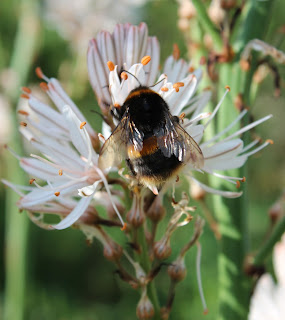 |
| Asphodelus aestivus (with buff-tailed bumble bee?) |
I have been asked about the overwintering habitats of different bee species (sorry, no idea) and whether I put out sugar water to feed them (heck, no). I have frequently been asked why I don’t keep bees, (because I see no need to confine them to barracks in order to nick their food stores, when I only eat half a jar a year) and which native wildflowers I grow and sell in order to entice bees into the garden (none specifically for that reason).
I have also, and reasonably, been asked which of the plants I stock are the best for bees. Now that one I can answer. I simply look around me on a sunny day and see which ones are beset by bees. And most of them are.
Plants bribe bees with nectar in order to get pollinated so that they can set seed and make babies. Put in rather more basic terms, plants pay bees for sex. So any plant which wants to set seed will produce nectar. If they don’t, they don’t get to mate with their neighbours. And their lives quite literally wouldn’t be worth living. Simple, isn’t it?
 |
| Geranium ‘Nimbus’ with red tailed bumble bee |
From our point of view as gardeners, this is great news. It means you don’t have to choose between a wilderness which is bee-friendly and an attractive garden which isn’t (yes, yes, I think wildflowers are beautiful too, but roll with me on this one…).
You absolutely can have a beautiful garden, as relaxed or as formal as you like and still attract insects galore. Just stuff it with plants that want to set seed and they’ll come flocking.
Dave and I wandered round the garden early this evening bee-spotting. All of these pictures were taken within that half an hour.
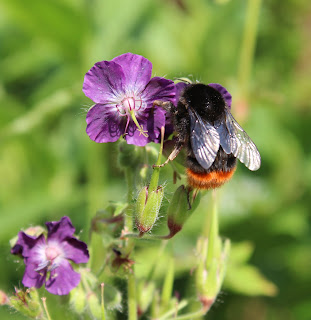 |
| Geranium phaeum |
All of the single geraniums attracted bees, from the finely bred Geranium ‘Nimbus’ above to the plain old maroon Geranium phaeum.
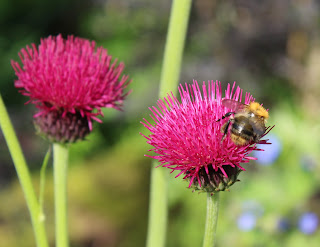 |
| Cirsium rivulare ‘Atropurpureum’ with a Carder bee? |
This stunning Cirsium pictured left, doesn’t even produce seeds. Yet it clearly hasn’t figured this out, or doesn’t care, because it pumps out nectar like Old Faithful. It’s a magnet for bees of all types. I don’t know bee names, but I can tell you that we counted four different species on this plant in the space of 5 minutes earlier this evening.
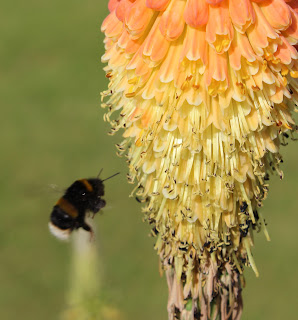 |
| Kniphofia with white-tailed bumble bee |
And even real plant foreigners like Kniphofias, with nectaries designed to attract hummingbirds still seem irresistible to these white-tailed bumble bee.
Allium ‘Purple Sensation’ is still a popular bee haunt, but they’re almost over now, so the bees are tackling the last emerging florets underneath each perfect sphere.
There were more that I couldn’t capture. Nepeta ‘Walkers Low’ is a favourite, but they flit in and out of the many tiny flowers too fast for me to capture. And Iris sibirica ‘Perry’s Blue’ attracted a huge stripy bee, but drew it in so deeply into the flower that I could only see its back legs.
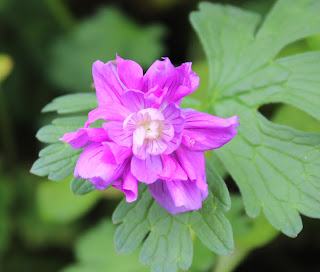 |
| Geranium pratense ‘Plenum Violaceum’ |
Frankly, it was hard to find a flower which got no bee attention at all. Geranium pratense ‘Plenum Violaceum’ was one. It’s a double flower, and I presume it’s sterile since it seems to lack anthers and stigma. And if it can’t produce seed it doesn’t need nectaries. It survives only because gardeners favour double flowers and so we humans choose to propagate the plant vegetatively. In the wild it would have died out. Without seeds a plant is at an evolututionary dead end.
So, attracting bees is easy. Choose plants with single flowers. Ideally ones with a central froth of quivering anthers, thick with pollen, or a sticky stigma, plump and waiting. Or, just wander round a garden on a sunny day and watch what the bees dive into. They know best.

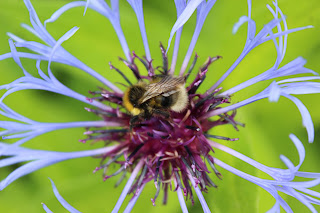
3 Responses to “Beauty and the Bees…”
Great post, I had the same thought last year when I wandered around the garden. I planted flowers to benefit my vegetables and they were full with bees and bumblebees. So the flowers did double duty!
Thanks, this is a really nicely written post.
Love the photos too!
Many thanks.
Excellent Sue, and as usual great pictures. I bought my first Cirsium at the weekend after a visit to Wisley. It was full of bees and looked gorgeous in the Wild Garden. Sure enough the bees found it straight away in my garden.